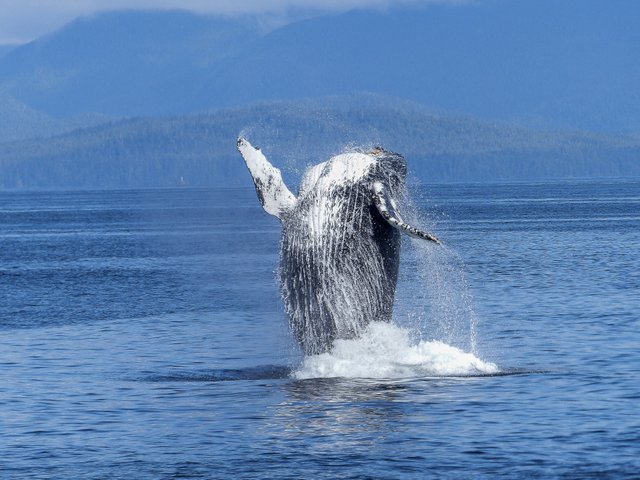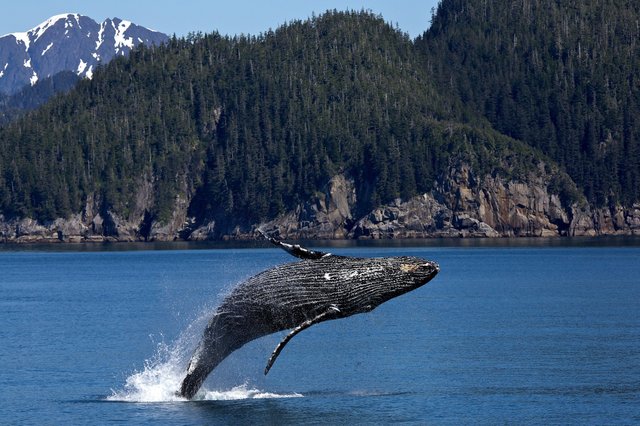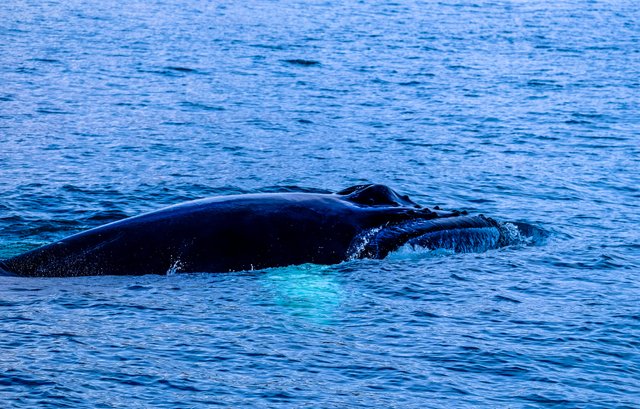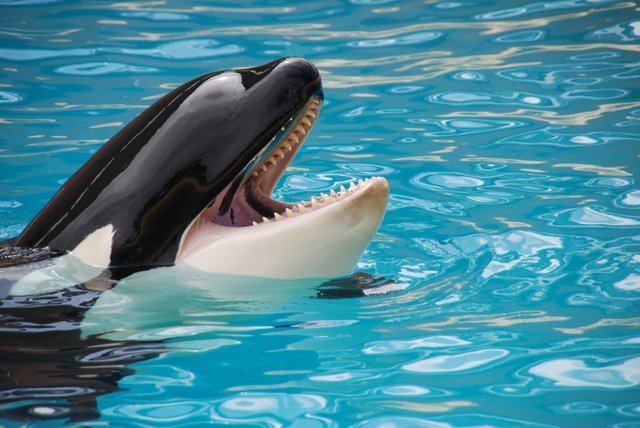WHALES
Whales are a widely distributed and diverse group of fully aquatic placental marine mammals.
 image
imageWhales are creatures of the open ocean, they feed, mate, give birth, suckle and raise their young one's at sea. So extreme is their adaptation to life underwater that they are unable to survive on land. Whales range in size from the 2.6 metres i.e 8.5ft and 135 kilograms, dwarf sperm whale to the 29.9 metres (98 ft) and 190 metric tons, blue whale, which is the largest creature that has ever lived.
The sperm whale is the largest toothed predator on earth. Several species exhibit sexual dimorphism, in that the females are larger than males. Baleen whales have no teeth; instead they have plates of baleen, a fringe-like structure used to expel water while retaining the krill and plankton which they feed on. They use their throat pleats to expand the mouth to take in huge gulps of water. Balaenids have heads that can make up 40% of their body mass to take in water. Toothed whales, on the other hand, have conical teeth designed for catching fish or squid. Baleen whales have a well developed sense of "smell", whereas toothed whales have well-developed hearing − their hearing, that is adapted for both air and water, is so well developed that some can survive even if they are blind. Some species, such as sperm whales, are well adapted for diving to great depths to catch squid and other favoured prey.
Whales have evolved from land-living mammals. As such whales must breathe air regularly, although they can remain submerged under water for long periods of time. Some species such as the sperm whale are able to stay submerged for as much as 90 minutes.[1] They have blowholes (modified nostrils) located on top of their heads, through which air is taken in and expelled. They are warm-blooded, and have a layer of fat, or blubber, under the skin. With streamlined fusiform bodies and two limbs that are modified into flippers, whales can travel at up to 20 knots, though they are not as flexible or agile as seals. Whales produce a great variety of vocalizations, notably the extended songs of the humpback whale. Although whales are widespread, most species prefer the colder waters of the Northern and Southern Hemispheres, and migrate to the equator to give birth. Species such as humpbacks and blue whales are capable of travelling thousands of miles without feeding. Males typically mate with multiple females every year, but females only mate every two to three years. Calves are typically born in the spring and summer months and females bear all the responsibility for raising them. Mothers of some species fast and nurse their young for one to two years.
Once relentlessly hunted for their products, whales are now protected by international law. The North Atlantic right whales nearly became extinct in the twentieth century, with a population low of 450, and the North Pacific grey whale population is ranked Critically Endangered by the IUCN. Besides whaling, they also face threats from bycatch and marine pollution. The meat, blubber and baleen of whales have traditionally been used by indigenous peoples of the Arctic. Whales have been depicted in various cultures worldwide, notably by the Inuit and the coastal peoples of Vietnam and Ghana, who sometimes hold whale funerals. Small whales, such as belugas, are sometimes kept in captivity and trained to perform tricks, but breeding success has been poor and the animals often die within a few months of capture. Whale watching has become a form of tourism around the world.
 image
imageSPECIES OF WHALE
●Blue whales:
The largest animals ever to have lived, dwarfing even the largest dinosaurs. Their circulatory system pumps 10 tonnes of blood through its body using a heart the size of a small car. A child could crawl down the whales' main blood vessel, the aorta. In its development, a blue whale calf can drink 50 gallons of its mother's milk and gain 200lbs per day.
●Right whale:
They are called "right" whales because they have large amounts of oil, blubber and baleen or whalebone, they are slow swimming (easy to catch), are often found close to shore and float when killed.
●Humpback whales:
So called because of the habit of raising and bending the back in preparation for a dive, accentuating the hump in front of the dorsal fin.
●Minke whales:
One of the smallest baleen or filter feeding whales. Minke numbers are still quite healthy due to whalers concentrating on larger, more profitable species.
●Fin whales:
The second largest after the blue whale, the fastest swimming of all the large whales.
Fin whales can produce sounds of 75-80dB at around 100Hz which is very loud for an animal source. In pre-propeller oceans this sound could travel for well over a hundred kilometres.
 image
image●Sperm whales:
The name comes from the enormous bulbous spermaceti organ in the head.
Only males are found in Antarctic waters. Sperm whales are toothed whales rather than filter feeders and are the deepest and longest of all whale divers catching giant squid in the dark ocean depths.
●Killer whales:
They are one of the most well known types of whales thanks to their being held captive in marine aquariums where they are taught to perform tricks.
Killer whales are toothed whales and top carnivores in their food chain. They are sometimes referred to as "sea-wolves". Their tastes are wide ranging from krill and fish to penguins, seals and even much larger baleen whales.
 image
image
Thanks